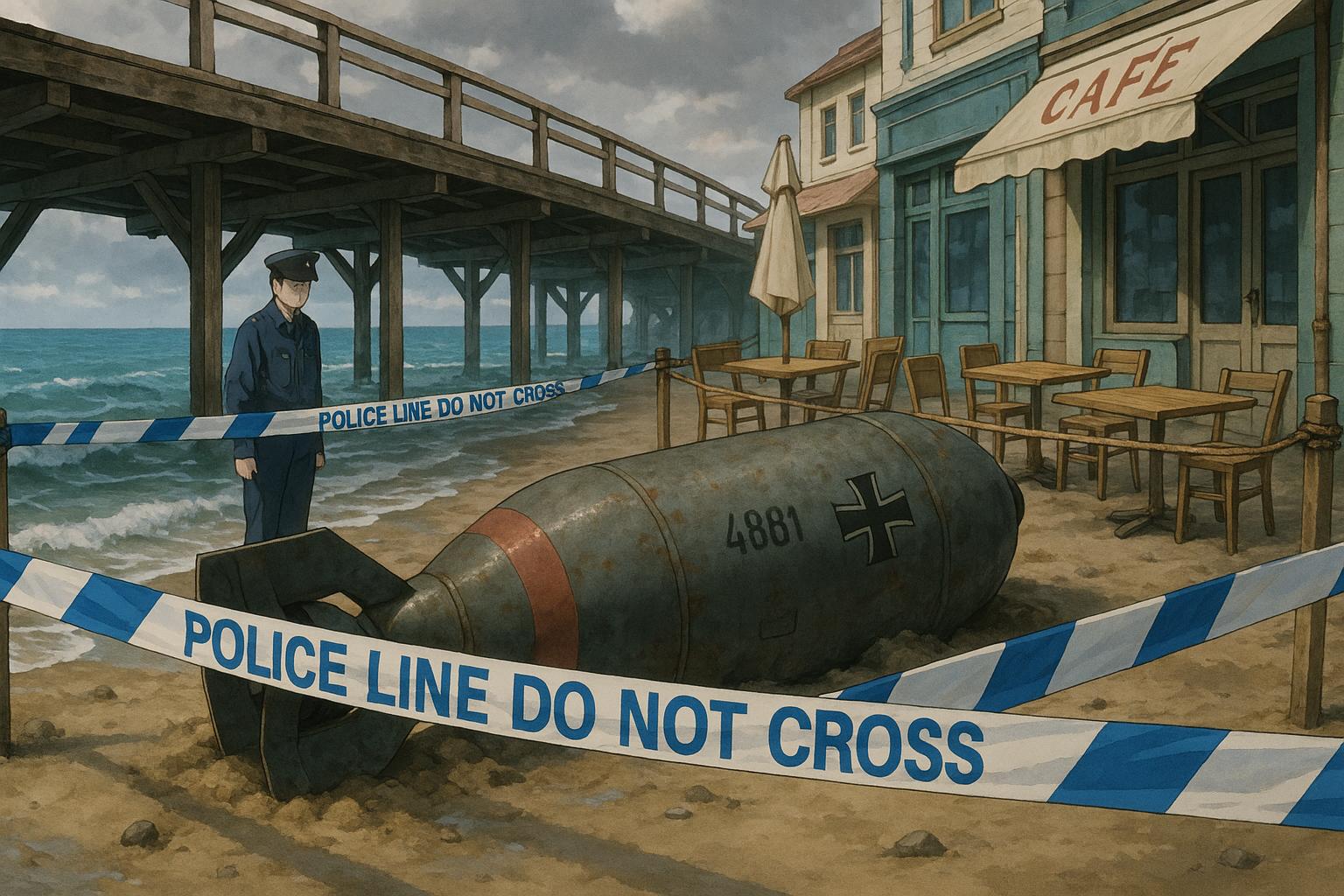Authorities have evacuated Teignmouth pier and nearby cafes following the discovery of a suspected explosive device, renewing concerns over wartime bombs surfacing on UK coastlines and highlighting ongoing safety precautions in the region.
Authorities in Teignmouth have evacuated a pier and several nearby cafes following the discovery of a suspected explosive device. A police cordon has been established to secure the area, emphasising the ongoing safety measures taken in response to potential risks associated with unexploded ordnance.
This incident echoes a significant event from July 2018, when a large World War II bomb was unearthed under Teignmouth Pier. It was found by two scuba divers who initially mistook the 1,200 kg device for a container. The explosive was identified as a German SC 1,200 model, which was subsequently confirmed to contain 631 kg of high-explosive material. The Royal Navy bomb disposal team was called in to handle the situation, necessitating the evacuation of parts of the town to ensure public safety. The bomb was eventually towed out to sea and detonated in a controlled explosion, a precautionary measure that highlighted the persistent dangers posed by remnants of the war, particularly along the UK’s coastlines.
Unexploded ordnance from World War II remains a pressing concern in densely populated areas. Just over a year later, in February 2024, a 500 kg bomb was unearthed in Plymouth, resulting in one of the largest peacetime evacuations in United Kingdom history, with more than 10,000 residents displaced as military personnel undertook a meticulous operation to safely remove the device. These incidents underscore the continuous challenge of managing unexploded weapons from the past, which often surface years later, presenting significant hazards to both public safety and local infrastructure.
The military's expertise in tackling such situations was previously demonstrated in Teignmouth itself, where strategic evacuations and cordons became crucial in mitigating risks when similar munitions were discovered. In 2018, a thorough response was facilitated by a meticulous Royal Navy team, which established a 500-meter safety perimeter while assessing and neutralising the threat. Such operations are not merely reactive but signify a broader understanding of the importance of preparedness in the face of historic explosives.
Additionally, in some cases, even smaller devices have triggered safety measures. For instance, a spigot mortar bomb found on Teignmouth beach in July 2018 led to the establishment of a 300-meter cordon around a popular seaside hotel while the device was deemed safe and removed. These discoveries serve as stark reminders of the wartime remnants that still lie beneath the surface, necessitating vigilance along coastal regions frequented by both residents and tourists.
As the operation continues in Teignmouth, the local community is left awaiting updates from officials. While the immediate threat is being addressed, the recurring emergence of these unexploded devices underscores the legacy of World War II and the necessity for ongoing vigilance in the region.
Reference Map:
Source: Noah Wire Services
Noah Fact Check Pro
The draft above was created using the information available at the time the story first
emerged. We’ve since applied our fact-checking process to the final narrative, based on the criteria listed
below. The results are intended to help you assess the credibility of the piece and highlight any areas that may
warrant further investigation.
Freshness check
Score:
6
Notes:
The narrative references a recent evacuation in Teignmouth due to a suspected explosive device found beneath the pier. However, similar incidents have occurred in the past, notably in July 2018, when a 1,200 kg German bomb was discovered under Teignmouth Pier. The Express article does not provide a specific date for the current event, making it challenging to assess its freshness accurately. The lack of a clear publication date and the absence of new, verifiable details suggest that the content may be recycled or based on older events. Additionally, the Express is known for republishing content across various platforms, which can lead to the dissemination of recycled news. The narrative also draws parallels with the 2018 incident, indicating a possible reuse of content. Without a specific date, the freshness score is moderate.
Quotes check
Score:
5
Notes:
The narrative includes direct quotes from individuals involved in the 2018 incident, such as James Cunningham and James Brown. These quotes have been previously published in other sources, indicating that they are reused from earlier reports. The repetition of these quotes suggests that the content may not be original. The lack of new, exclusive quotes further supports this assessment.
Source reliability
Score:
4
Notes:
The narrative originates from the Express, a publication known for sensationalist reporting and a history of republishing content across various platforms. This raises concerns about the reliability and originality of the information presented. The absence of new, verifiable details and the reliance on previously published quotes further diminish the credibility of the source.
Plausability check
Score:
6
Notes:
The narrative discusses the discovery of a suspected explosive device beneath Teignmouth Pier, leading to evacuations. While such incidents have occurred in the past, the lack of specific details, such as the exact date of the current event, makes it difficult to verify the plausibility of this particular claim. The reliance on past events and the absence of new, corroborated information suggest that the narrative may be based on recycled content.
Overall assessment
Verdict (FAIL, OPEN, PASS): FAIL
Confidence (LOW, MEDIUM, HIGH): HIGH
Summary:
The narrative appears to be recycled from previous reports, lacking new, verifiable details and relying on previously published quotes. The absence of a specific publication date and the use of content from past incidents raise significant concerns about the freshness and originality of the information. The Express's history of republishing content across various platforms further diminishes the credibility of the source. Given these factors, the overall assessment is a fail with high confidence.
